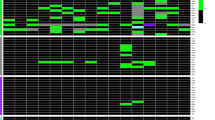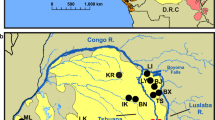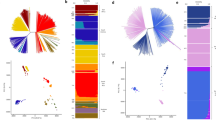Abstract
New strategies are required to identify the most important targets of protective immunity in complex eukaryotic pathogens. Natural selection maintains allelic variation in some antigens of the malaria parasite Plasmodium falciparum1,2,3. Analysis of allele frequency distributions could identify the loci under most intense selection4,5,6,7. The merozoite surface protein 1 (Msp1) is the most-abundant surface component on the erythrocyte-invading stage of P. falciparum8,9,10. Immunization with whole Msp1 has protected monkeys completely against homologous11 and partially against non-homologous12 parasite strains. The single-copy msp1 gene, of about 5 kilobases, has highly divergent alleles13 with stable frequencies in endemic populations14,15. To identify the region of msp1 under strongest selection to maintain alleles within populations, we studied multiple intragenic sequence loci in populations in different regions of Africa and Southeast Asia. On both continents, the locus with the lowest inter-population variance in allele frequencies was block 2, indicating selection in this part of the gene. To test the hypothesis of immune selection, we undertook a large prospective longitudinal cohort study. This demonstrated that serum IgG antibodies against each of the two most frequent allelic types of block 2 of the protein were strongly associated with protection from P. falciparum malaria.
This is a preview of subscription content, access via your institution
Access options
Subscribe to this journal
Receive 12 print issues and online access
$209.00 per year
only $17.42 per issue
Buy this article
- Purchase on Springer Link
- Instant access to full article PDF
Prices may be subject to local taxes which are calculated during checkout
Similar content being viewed by others
References
Hughes, M. K. & Hughes, A. L. Natural selection on Plasmodium surface proteins. Mol. Biochem. Parasitol. 71, 99–113 (1995).
Conway, D.J. Natural selection on polymorphic malaria antigens and the search for a vaccine. Parasitol. Today 13, 26–29 (1997).
Escalante, A.A., Lal, A.A. & Ayala, F.J. Genetic polymorphism and natural selection in the malaria parasite Plasmodium falciparum. Genetics 149, 189–202 (1998).
Berry, A. & Kreitman, M. Molecular analysis of an allozyme cline: Alcohol dehydrogenase in Drosophila melanogaster on the east coast of North America. Genetics 134, 869–893 (1993).
Taylor, M.F.J., Shen, Y. & Kreitman, M.E. A population genetic test of selection at the molecular level. Science 270, 1497–1499 (1995).
McDonald, J.H. in Non-Neutral Evolution: Theories and Molecular Data. (ed. Golding, B.) 88–100 (Chapman–Hall, London, UK, 1994).
Beaumont, M.A. & Nichols, R.A. Evaluating loci for use in the genetic analysis of population structure. Proc. R. Soc. Lond. B 263, 1619–1626 (1996).
Holder, A.A. et al. Primary structure of the precursor to the three major surface antigens of Plasmodium falciparum merozoites. Nature 317, 270–273 (1985).
McBride, J.S. & Heidrich, H.-G. Fragments of the polymorphic Mr 185 000 glycoprotein from the surface of isolated Plasmodium falciparum merozoites form an antigenic complex. Mol. Biochem. Parasitol. 23, 71–84 (1987).
Blackman, M.J., Heidrich, H.-G., Donachie, S., McBride, J.S. & Holder, A.A. A single fragment of a malaria merozoite surface protein remains on the parasite during red cell invasion and is the target of invasion-inhibiting antibodies. J. Exp. Med. 172, 379–382 (1990).
Siddiqui, W.A. et al. Merozoite surface coat precursor protein completely protects Aotus monkeys against Plasmodium falciparum malaria. Proc. Natl. Acad. Sci., USA 84, 3014–3018 (1987).
Hall, R. et al. Major surface antigen gene of a human malaria parasite cloned and expressed in bacteria. Nature 311, 379–382 (1984).
Tanabe, K., Mackay, M., Goman, M. & Scaife, J.G. Allelic dimorphism in a surface antigen gene of the malaria parasite Plasmodium falciparum. J. Mol. Biol. 195, 273–287 (1987).
Conway, D.J., Greenwood, B.M. & McBride, J.S. Longitudinal study of Plasmodium falciparum polymorphic antigens in a malaria endemic population. Infect. Immun. 60, 1122–1127 (1992).
Ferreira, M.U. et al. Stable patterns of allelic diversity at the merozoite surface protein-1 locus of Plasmodium falciparum in clinical isolates from southern Vietnam. J. Euk. Microbiol. 45, 131–136 (1998).
Conway, D.J. et al. High recombination rate in natural populations of Plasmodium falciparum. Proc. Natl. Acad. Sci. USA 96, 4506–4511 (1999).
Weir, B.S. & Cockerham, C.C. Estimating F statistics for the analysis of population structure. Evolution 38, 1358–1370 (1984).
Su, X.-Z. & Wellems, T.E. Towards a high resolution Plasmodium falciparum linkage map: Polymorphic markers from hundreds of simple sequence repeats. Genomics 33, 430–444 (1996).
Anderson, T.J.C., Su, X.-Z., Bockaire, M., Lagog, M. & Day, K.P. Twelve microsatellite markers for characterisation of Plasmodium falciparum from finger prick blood samples. Parasitology 119, 113–125 (1999).
Sakihama, N. et al. Allelic recombination and linkage disequilibrium within Msp-1 of Plasmodium falciparum, the malignant human malaria parasite. Gene 230, 47–54 (1999).
Locher, C.P., Tam, L.Q., Chang, S.P., McBride, J.S. & Siddiqui, W.A. Plasmodium falciparum : gp195 tripeptide repeat-specific monoclonal antibody inhibits parasite growth in vitro. Exp. Parasitol. 84, 74–83 (1996).
Miller, L.H., Roberts, T., Shahabuddin, M. & McCutchan, T.F. Analysis of sequence diversity in the Plasmodium falciparum merozoite surface protein-1 (MSP-1). Mol. Biochem. Parasitol. 59, 1–14 (1993).
Cavanagh, D.R. & McBride, J.S. Antigenicity of recombinant proteins derived from Plasmodium falciparum merozoite surface protein 1. Mol. Biochem. Parasitol. 85, 197–211 (1997).
Cavanagh, D.R. et al. A longitudinal study of type-specific antibody responses to Plasmodium falciparum merozoite surface protein-1 in an area of unstable malaria in Sudan. J. Immunol. 161, 347–359 (1998).
D'cAlessandro, U. et al. Efficacy trial of the malaria vaccine SPf66 in Gambian infants. Lancet 346, 462–467 (1995).
Riley, E.M. et al. Naturally acquired cellular and humoral immune responses to the major merozoite surface antigen (PfMSP1) of Plasmodium falciparum are associated with reduced malaria morbidity. Parasite Immunol. 14, 321–337 (1992).
Al-Yaman, F. et al. Assessment of the role of naturally acquired antibody levels to Plasmodium falciparum merozoite surface protein-1 in protecting Papua New Guinean children from malaria mortality. Am. J. Trop. Med. Hyg. 54, 443–448 (1996).
Egan, A.F. et al. Clinical immunity to Plasmodium falciparum malaria is associated with serum antibodies to the 19kDa C-terminal fragment of the merozoite surface antigen, PfMSP1. J. Infect. Dis. 173, 765–769 (1996).
Dodoo, D. et al. Levels of antibody to conserved parts of Plasmodium falciparum merozoite surface protein 1 in Ghanaian children are not associated with protection from clinical malaria. Infect. Immun. 67, 2131–2137 (1999).
Morgan, W.D. et al. Solution structure of an EGF module pair from the Plasmodium falciparum merozoite surface protein 1. J. Mol. Biol. 289, 113–122 (1999).
Patino, J.A., Holder, A.A., McBride, J.S. & Blackman, M.J. Antibodies that inhibit malaria merozoite surface protein-1 processing and erythrocyte invasion are blocked by naturally acquired human antibodies. J. Exp. Med. 186, 1689–1699 (1997).
Gupta, S. et al. The maintenance of strain structure in populations of recombining infectious agents. Nature Med. 2, 437–442 (1996).
Hastings, I. Population genetics and the detection of immunogenic and drug-resistant loci in Plasmodium. Parasitol. 112, 155–164 (1996).
Conway, D.J., Greenwood, B.M. & McBride, J.S. The epidemiology of multiple-clone Plasmodium falciparum infections in Gambian patients. Parasitology 103, 1–6 (1991).
Kaneko, O., Kimura, M., Kawamoto, F., Ferreira, M.U. & Tanabe, K. Plasmodium falciparum: Allelic variation in the merozoite surface protein 1 gene in wild isolates from southern Vietnam. Exp. Parasitol. 86, 45–57 (1997).
Burghaus, P.A. & Holder, A.A. Expression of the 19-kilodalton carboxy-terminal fragment of the Plasmodium falciparum merozoite surface protein-1 in Escherichia coli as a correctly folded protein. Mol. Biochem. Parasitol. 64, 165–169 (1994).
Egan, A.F. et al. Serum antibodies from malaria-exposed people recognize conserved epitopes formed by the two epidermal growth factor motifs of MSP1(19), the carboxy-terminal fragment of the major merozoite surface protein of Plasmodium falciparum. Infect. Immun. 63, 456–466 (1995).
Acknowledgements
We thank O. Ogundahunsi, M. Grobusch, K. Hirayama, K. Na-Bangchang, C. Curtis, J. Trigg, J. Curtis, G. Warnasuriya, and D. Warhurst for support with sample collection and processing; H. Weiss for help with the cohort study database; T. Anderson for advice on microsatellites; and R. Gregory for technical assistance with the ABI 377. This work was supported by The Wellcome Trust (grant references 013163/Z/94/B,C and 0471191/Z/96), the UK Medical Research Council (grant reference G9803180), and The Ministry of Education, Science and Culture, Japan.
Author information
Authors and Affiliations
Corresponding author
Rights and permissions
About this article
Cite this article
Conway, D., Cavanagh, D., Tanabe, K. et al. A principal target of human immunity to malaria identified by molecular population genetic and immunological analyses. Nat Med 6, 689–692 (2000). https://doi.org/10.1038/76272
Received:
Accepted:
Issue Date:
DOI: https://doi.org/10.1038/76272
This article is cited by
-
The diversity of Plasmodium falciparum isolates from asymptomatic and symptomatic school-age children in Kinshasa Province, Democratic Republic of Congo
Malaria Journal (2023)
-
Structural organization and sequence diversity of the complete nucleotide sequence encoding the Plasmodium malariae merozoite surface protein-1
Scientific Reports (2022)
-
Dynamic changes in genetic diversity, drug resistance mutations, and treatment outcomes of falciparum malaria from the low-transmission to the pre-elimination phase on the islands of São Tomé and Príncipe
Malaria Journal (2021)
-
Afucosylated Plasmodium falciparum-specific IgG is induced by infection but not by subunit vaccination
Nature Communications (2021)
-
In silico characterisation of putative Plasmodium falciparum vaccine candidates in African malaria populations
Scientific Reports (2021)



